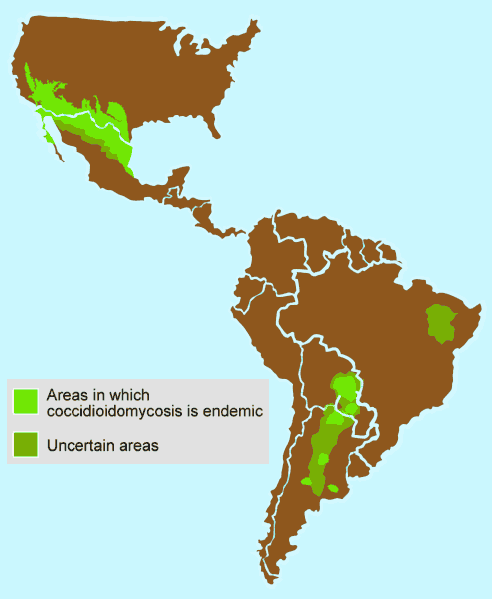Coccidioidomycosis epidemiology and demographics
|
Coccidioidomycosis Microchapters |
|
Diagnosis |
|---|
|
Treatment |
|
Case Studies |
|
Coccidioidomycosis epidemiology and demographics On the Web |
|
American Roentgen Ray Society Images of Coccidioidomycosis epidemiology and demographics |
|
Coccidioidomycosis epidemiology and demographics in the news |
|
Risk calculators and risk factors for Coccidioidomycosis epidemiology and demographics |
Editor-In-Chief: C. Michael Gibson, M.S., M.D. [1]; Associate Editor(s)-in-Chief: ; Vidit Bhargava, M.B.B.S [2] Aditya Ganti M.B.B.S. [3]
Overview
The annual incidence of coccidioidomycosis in United states is variable but overall is increasing, from a rate of 5.3 per 100,000 in 1998 to a rate of 42.6 in 2011.The case fatality rate of coccidioidomycosis is approximately 0.59 per million person if left untreated. In 2005 and 2006, the Pleasant Valley State Prison near Coalinga and Avenal State Prison near Avenal on the western side of the San Joaquin Valley had the highest incidence rate in 2005, of at least 3,000 per 100,000. It is endemic in certain parts of Arizona, California, Nevada, New Mexico, Texas, Utah and northwestern Mexico.[1]
Epidemiology and Demographics
Epidemiology and Demographics of Coccidioidomycosis include:[2][3][4][5]
Incidence
- The annual incidence of coccidioidomycosis in United states is variable but overall is increasing, from a rate of 5.3 per 100,000 in 1998 to a rate of 42.6 in 2011.
- Arizona has the highest incidence of coccidioidomycosis of any state, with a yearly rate of approximately 248 cases per 100,000 population in 2011.
- 95% of all coccidioidomycosis cases in the USA occur in Arizona and California, with 70 % being in Arizona and rest from California.
- As per CDC [4] in 2010 there were over 16,000 reported cases of coccidioidomycosis most of which were localized to Arizona and California.
Case fatality rate
- The case fatality rate of coccidioidomycosis is approximately 0.59 per million person if left untreated.[6]

Demographics
Age
- Coccidioidomycosis affects all age groups.
- The higher incidence rates have been documented among adults >65 years.
Gender
- Men are more commonly affected with coccidioidomycosis than women.
Race
- Racial predilection for Filipino or African American patients has been reported to have higher rates of infection and dissemination, ranging from 10 to 175 times higher than other ethnicities.
Geographic distribution
- Coccidioidomycosis is found only in the Western hemisphere. It is endemic in certain parts of Arizona, California, Nevada, New Mexico, Texas, Utah and northwestern Mexico.
- It has been made a mandatory reportable disease in 15 US states, which includes Arizona, California, Delaware, Louisiana, Maryland, Michigan, Minnesota, Missouri, Nevada, New Hampshire, New Mexico, Ohio, Rhode Island, Utah, and Wyoming

References
- ↑ Hector R, Laniado-Laborin R (2005). "Coccidioidomycosis--a fungal disease of the Americas". PLoS Med. 2 (1): e2. PMID 15696207.
- ↑ Thompson, George; Brown, Jennifer; Benedict, Kaitlin; Park, Benjamin (2013). "Coccidioidomycosis: epidemiology". Clinical Epidemiology: 185. doi:10.2147/CLEP.S34434. ISSN 1179-1349.
- ↑ "www.cdph.ca.gov" (PDF).
- ↑ Barker BM, Jewell KA, Kroken S, Orbach MJ (2007). "The population biology of coccidioides: epidemiologic implications for disease outbreaks". Ann. N. Y. Acad. Sci. 1111: 147–63. doi:10.1196/annals.1406.040. PMID 17344537.
- ↑ Saubolle MA, McKellar PP, Sussland D (2007). "Epidemiologic, clinical, and diagnostic aspects of coccidioidomycosis". J. Clin. Microbiol. 45 (1): 26–30. doi:10.1128/JCM.02230-06. PMC 1828958. PMID 17108067.
- ↑ "Figure 1 - Coccidioidomycosis-associated Deaths, United States, 1990–2008 - Volume 18, Number 11—November 2012 - Emerging Infectious Disease journal - CDC".